Reviews
Why KAWS’s Global Success May Well Be a Symptom of a Depressed Culture, Adrift in Nostalgia and Retail Therapy
How to make sense of the popularity of an artist known for sad cartoons and collectable toys?
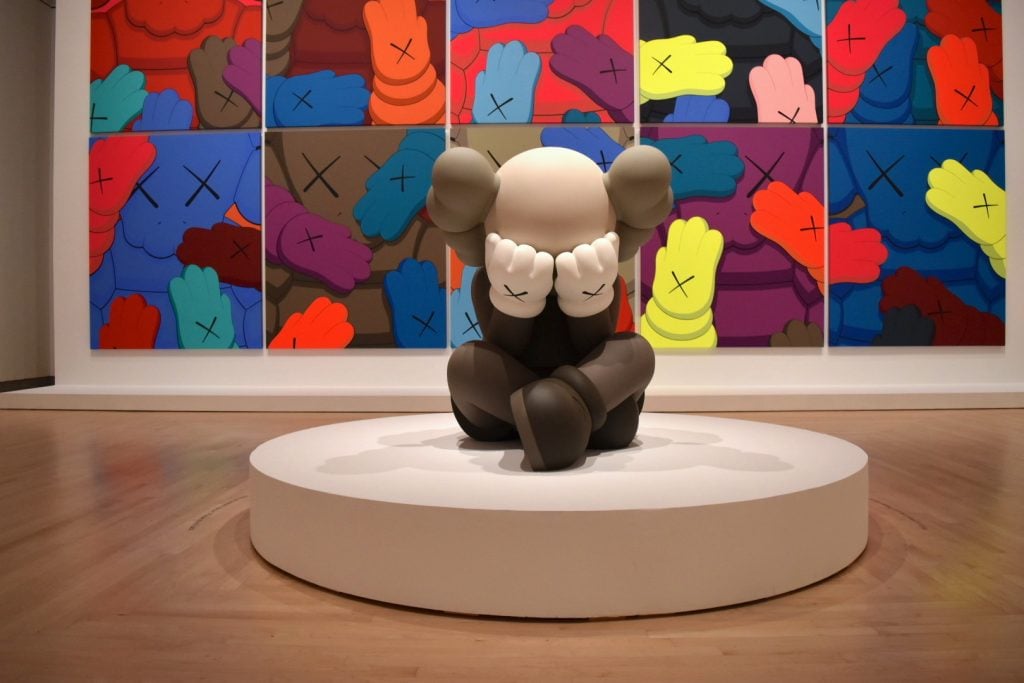
How to make sense of the popularity of an artist known for sad cartoons and collectable toys?

Ben Davis

The Brooklyn Museum show, “KAWS: WHAT PARTY,” does a good job taking KAWS seriously but not too seriously. They could have wasted a lot more time making overblown claims about the work’s profundity to try to justify its significance before the gaze of skeptics like myself. They don’t.
It’s a show for the fans—the many, many KAWS fans. It begins with a case of photos of KAWS’s ‘90s graffiti next to a few examples of his “subvertisements,” urban interventions for which he inserted his own cartoon graphics into ads displayed around the city.
Then there are his paintings, featuring images of ‘80s and ‘90s American cartoon characters like the Smurfs and the Simpsons with their eyes crossed out—his signature motif.
There are copious examples of his Companion character, his most familiar invention: a grey, skull-headed Mickey Mouse-ish creature, produced at scales ranging from collectible vinyl figurines to the brobdingnagian versions of the slouching creature, meticulously crafted in wood, that greet you in the museum lobby.
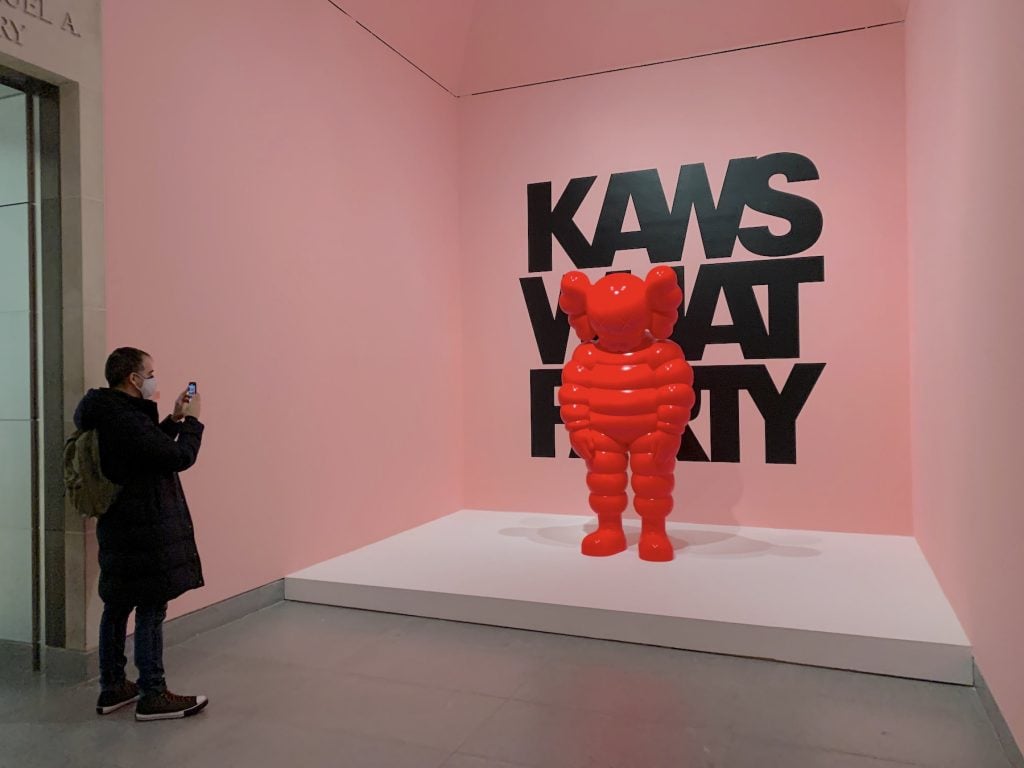
Entry to “KAWS: WHAT PARTY” at the Brooklyn Museum. (Photo by Ben Davis)
Evidence of KAWS’s innumerable product collaborations is reverentially displayed: His skateboard decks, sneaker collabs, the trophy he made for the MTV Music Video Awards, some furniture he did with the Campana Brothers.
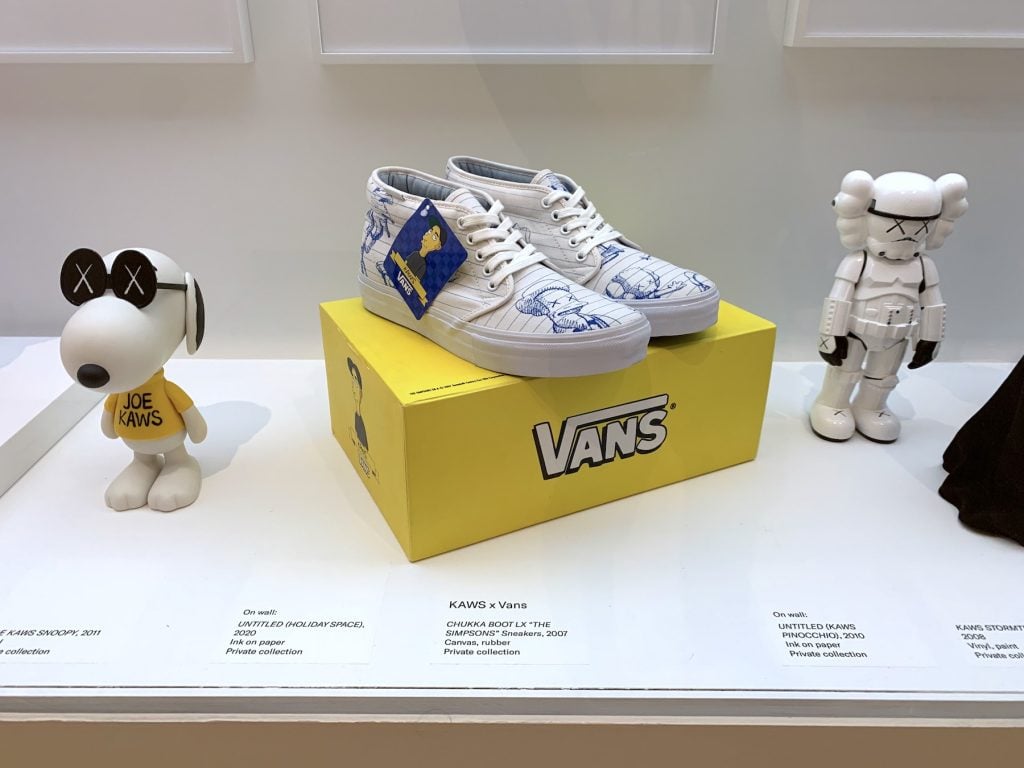
Display of KAWS-branded Vans. (Photo by Ben Davis)
Then there’s a gallery that shows a video of his recent exploits, from launching one of his Companion figures into low-earth orbit to floating a colossal inflatable version in Hong Kong’s Victoria Harbor.
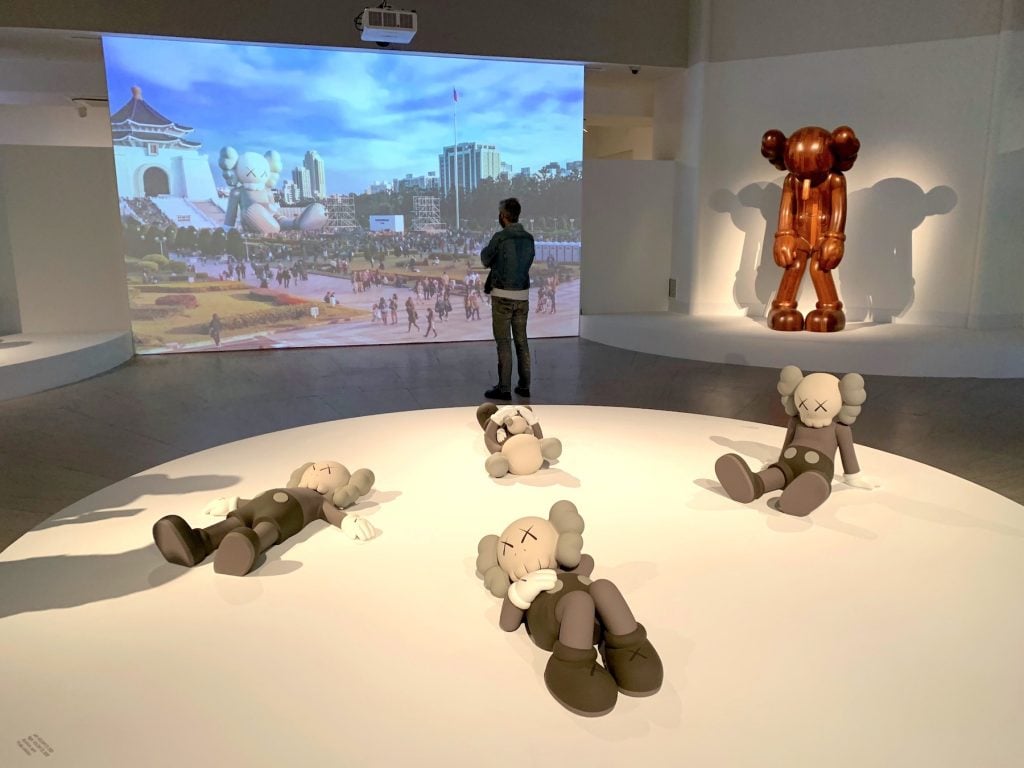
Installation view of “KAWS: WHAT PARTY” at the Brooklyn Museum. (Photo by Ben Davis)
The tale of KAWS, aka Brian Donnelly, has been told better elsewhere by William S. Smith and, most recently, Michael H. Miller. I won’t retrace his path from Jersey tagger to New York art student to opening his own boutique and selling his “art toys” in 2000s Tokyo—this last being the beachhead from which he infiltrated hip-hop, fashion, and celebrity circles, gaining the globe-spanning army of followers that allowed him to surround and then at last conquer the fine art world of galleries and museums.
I have to admit that trying to understand why KAWS’s Companion character has become such a beloved icon for so many people is, to me, a bit like encountering a cult worshipping the Flying Spaghetti Monster. I can understand the function of its rituals through sympathetic observation—but some part of me is always checking myself and saying, “You’re joking, right?”
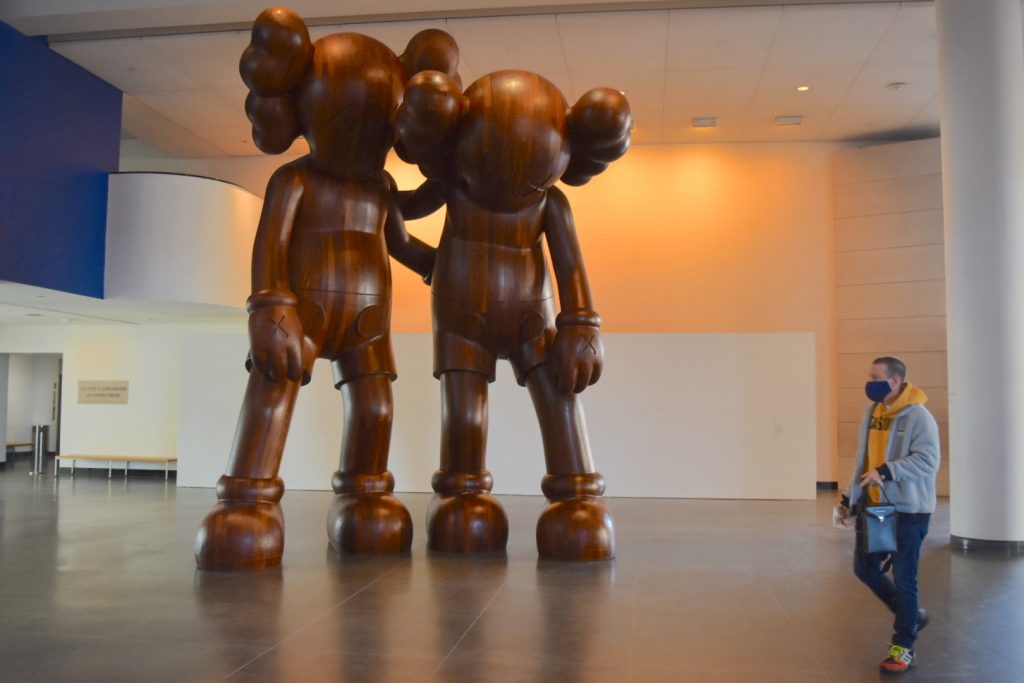
KAWS, Along the Way (2013). (Photo by Ben Davis)
Yet the Flying Spaghetti Monster cult is just a metaphor for how strange the beliefs of any organized religion are to a non-believer, and, similar to the case of religion, part of the story has to be an understanding that my own skepticism might actually be the eccentric position when viewed from the POV of the wider public. The Cult of KAWS is closer to some general sense of what a very large and enthusiastic public wants from art.
So, why? What itch does it scratch?
We live in an era of reboots and remakes, of regurgitated intellectual property. The most mainstream layer of mainstream culture consists of things like comic book movies and Star Wars, reprocessing teenage affections in endlessly permuting ways. What, in visual art, hits this same nerve?
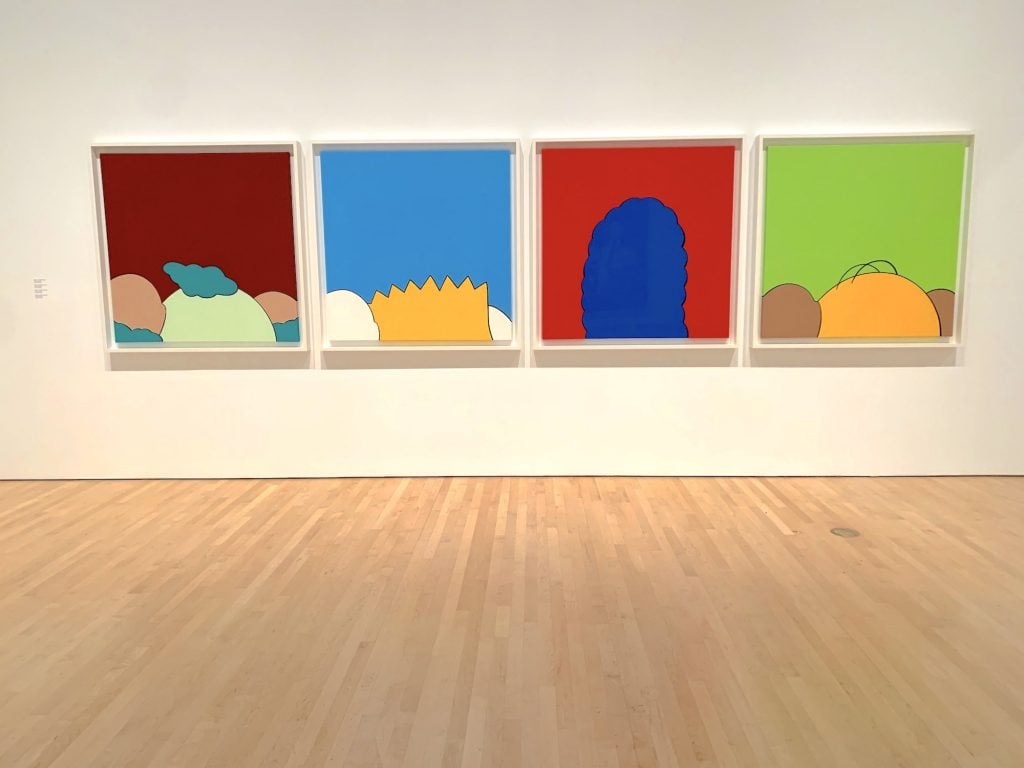
KAWS, Small K Landscape (2001), Small B Landscape (2001), Small B Landscape (2001), and Small H Landscape (2001). (Photo by Ben Davis)
An artist like KAWS is the best avatar: His main artistic device is to appropriate a familiar cartoon, tweak it, then tweak that tweaked appropriation again, and on and on, developing his own freestanding world.
A genre of YouTube movie criticism you see a lot these days is centered around parsing the lore of the big pop nostalgia mythologies. “Criticism” is actually the wrong word—it’s more like the cataloging of Easter eggs, the spotting of background references and links to source material and fan theories. Vast empires of content are spun out of this breezy sort of exegesis. It’s probably the dominant kind of film commentary, an almost utterly hermetically sealed cross-referencing operation.
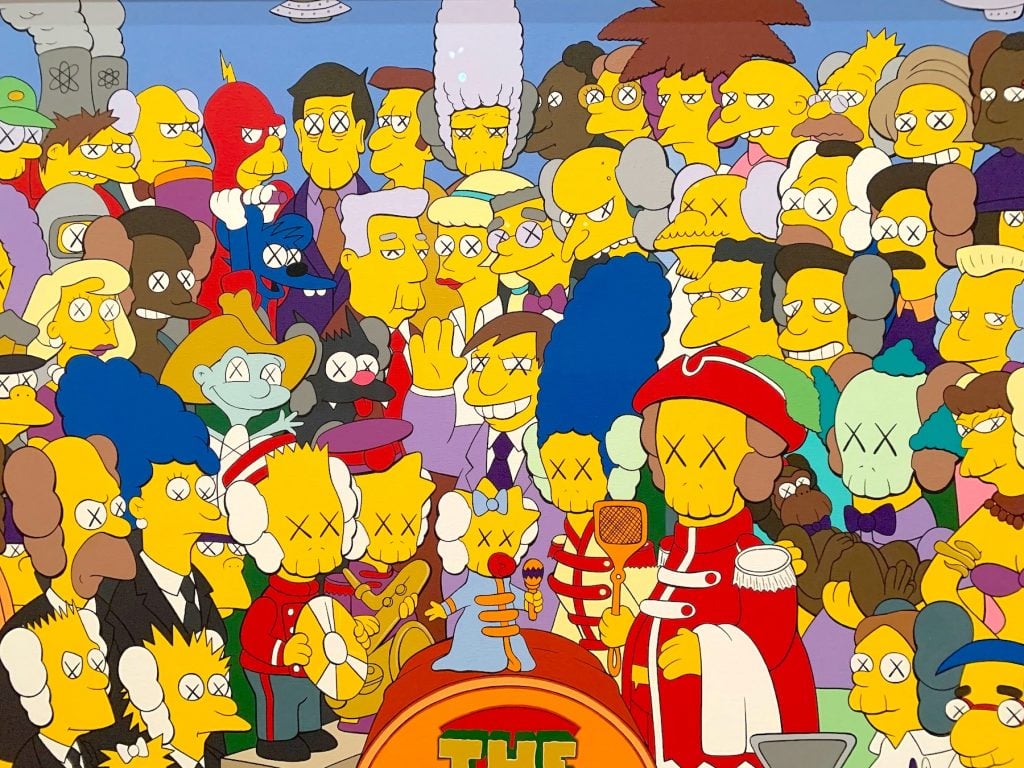
KAWS, The KAWS Album (detail). (Photo by Ben Davis)
The pleasure inspired by KAWS’s corpus rides a similar vibe. You get an easy hit of feeling smart for knowing what a “KAWS” is, parsing his source materials and the artist’s telltale operations on it. You feel a sense of being a part of a fan community keeping up with the adventures of the Companion as it rambles through culture.
Thus, “KAWS: WHAT PARTY” doesn’t lend itself to criticism so much as a kind of spot-the-reference approach: This is KAWS doing Gumby; this is a KAWS Elmo combined with KAWS’s Michelin Man-inspired character, Chum; this version of the Companion is the large-sized version of that Companion figurine; and so on.
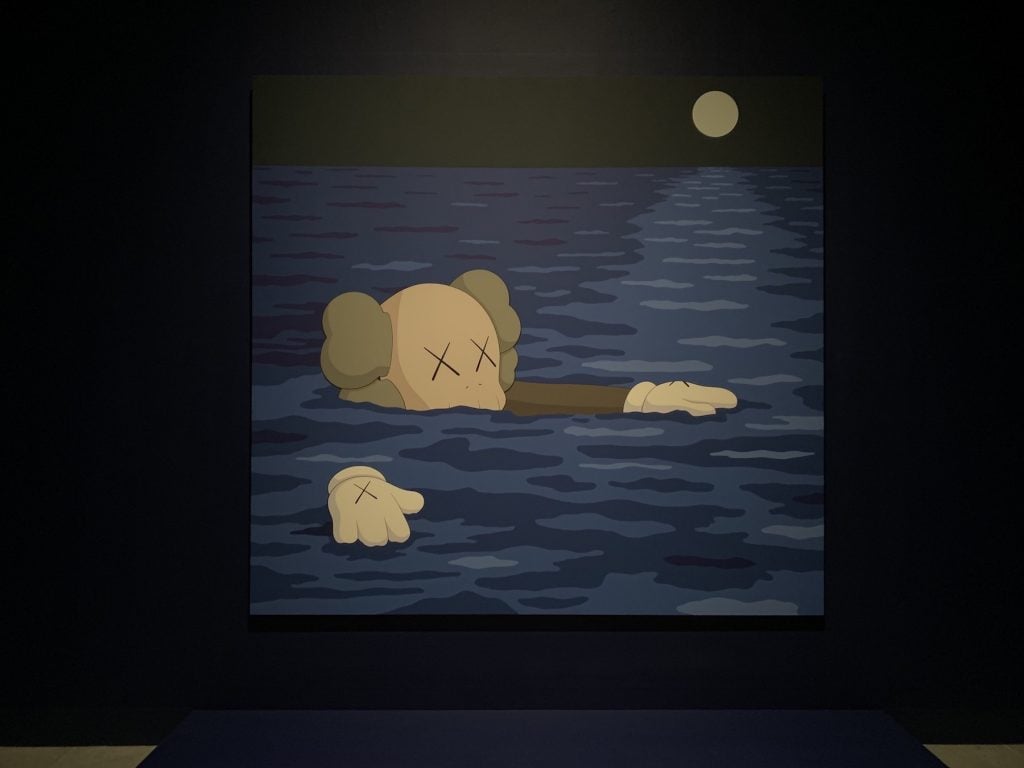
KAWS, Tide (2020). (Photo by Ben Davis)
Nestled reverentially in a blue-painted back gallery at the Brooklyn Museum is Tide (2020), a large canvas showing what appears to be the Companion in the ocean, its skull head and X eyes held above the water, arms akimbo.
I stood in the gallery and looked for a good long time at Tide. Usually, sustained attention unlocks a painting, as you become aware of the decisions the artist has made in constructing the image, percolating underneath the first impression.
In this case, I mainly became aware of how, when you look at the way the water meets the head and arm of the Companion, it seems to be rendered as flat as if it were a cardboard cut-out.
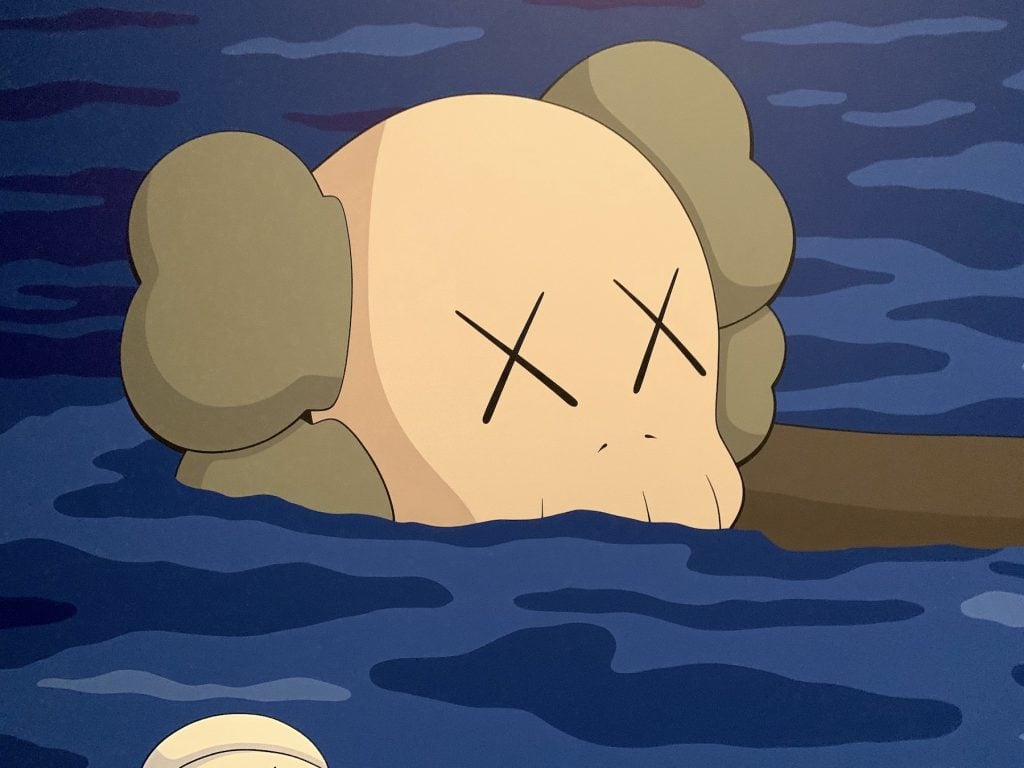
Detail of KAWS, Tide (2020). (Photo by Ben Davis)
I also noticed how the hand floats free at bottom left. The more I look at it, the more it seems disconnected from the body, just sort of bobbing on the surface of the water.
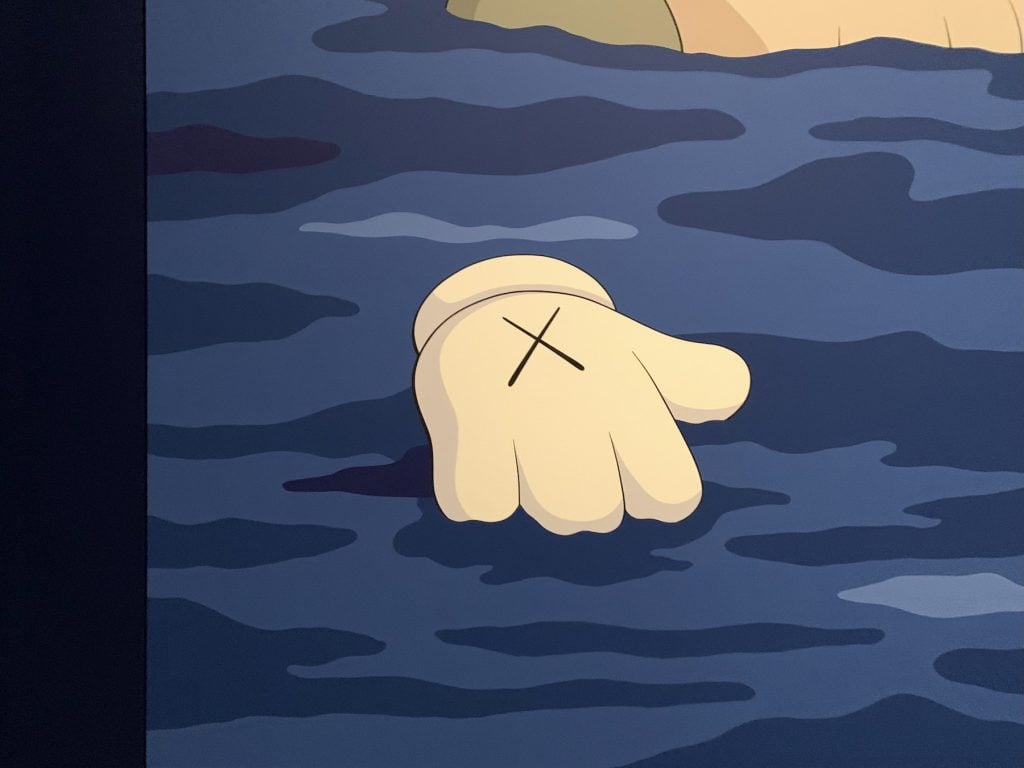
Detail of KAWS, Tide (2020). (Photo by Ben Davis)
What to do with such trivial observations? Maybe the painting’s shallowness deliberately evokes the expedient simplicity of animation cells (Donnelly worked as an animator in the ‘90s, on Nickelodeon’s Doug among other shows). Maybe it’s just not meant to be looked at that closely and mined for detail-level pleasures in that way.
Is KAWS an artist for the ages? Any artist who works with appropriated pop culture is going to be compared to Andy Warhol. But put it this way: He’s probably less a new-model Andy Warhol than a new-model Peter Max.
Max was immensely popular in the 1960s, famous enough to appear on the Tonight Show and on the cover of Time magazine under the heading “Portrait of the Artist as a Very Rich Man.” He exploited developments in commercial color printing to become a king of dorm-room posters. His then-fresh florescent palette and riffs on pop culture hit the button of something that was going on in the culture, the hunger for intense and ecstatic experiences—but it didn’t much outlive that cultural moment.
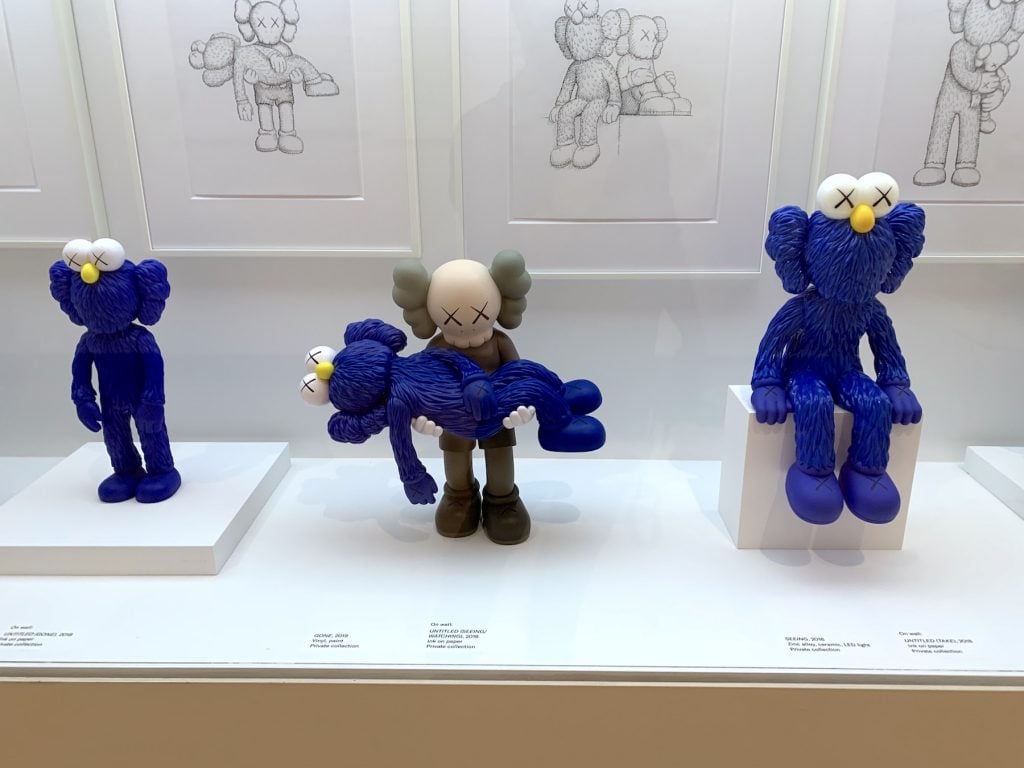
Display of vinyl figures by KAWS. (Photo by Ben Davis)
If you take KAWS’s popularity as a verdict on Today’s Culture in a similar way, the main thing you notice about the work is that, despite its poppy veneer, it is not ecstatic, not intense. The overall air is of emotional constipation. Kanye West was perceptive in picking KAWS for the cover of 808s & Heartbreak, an album whose autotuned aura was memorably about numbness and dissociation.
KAWS’s characters’ mouths go missing and eyeballs are either X’ed out or replaced by X’s. The Companion is always covering its eyes or slumped or copping a pathetic Pietà pose. Dismembered limbs float purposelessly, or the Companion’s body is sliced open like a medical model to show its guts, while the creature just stares, blankly.
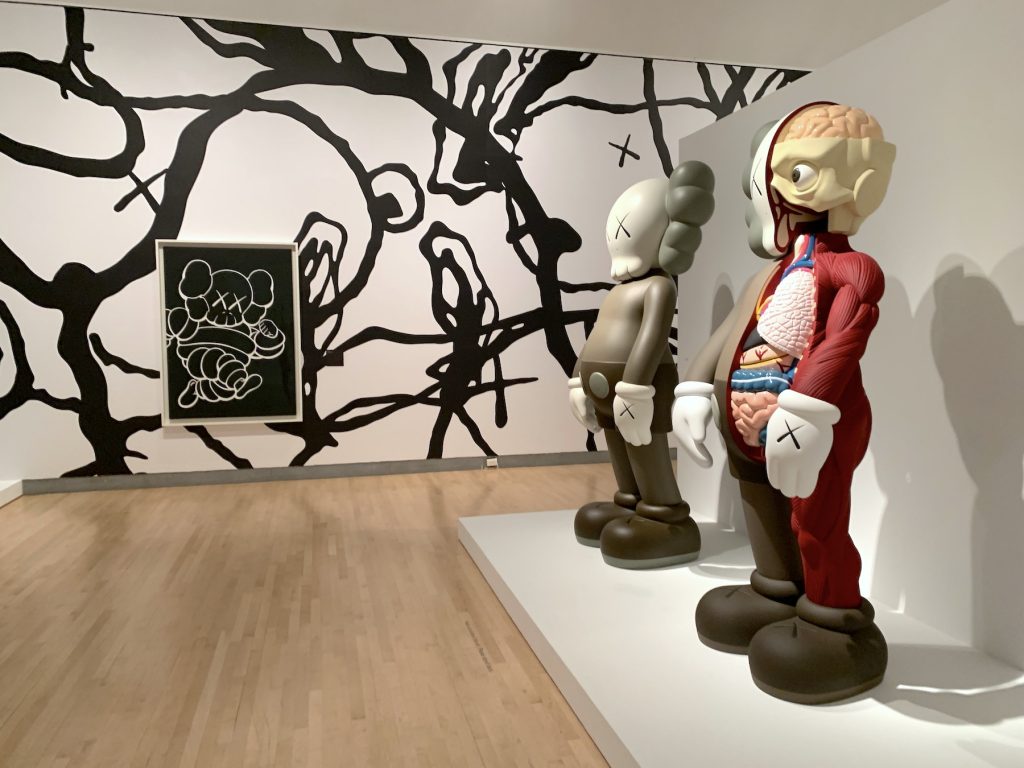
KAWS, Companion (Original Fake) (2011). (Photo by Ben Davis)
Maybe these goofy-dark flourishes are just meant to balance the fat of cutesy cartoons with a little acid. They register an emotion without really making you feel that emotion. The work’s very vacantness seems to suggest a low-level depression running through society, so pervasive that it serves as a neutral sign of the art’s nowness, rather than reading as a personal feeling expressed by the artist.
How does this observation fit, though, with the genial riffs on the Simpsons, the Smurfs, Peanuts, SpongeBob, Star Wars, and Astroboy that the KAWS universe emerged from in the ’00s, now frozen into a crystal of Gen X nostalgia? Pretty neatly, actually. As one psychologist told the Today Show, returning to the cultural pleasures of a perceived simpler earlier time is a coping mechanism: “When people are stressed, or anxious, or feeling out of control, nostalgia helps calm them down.”
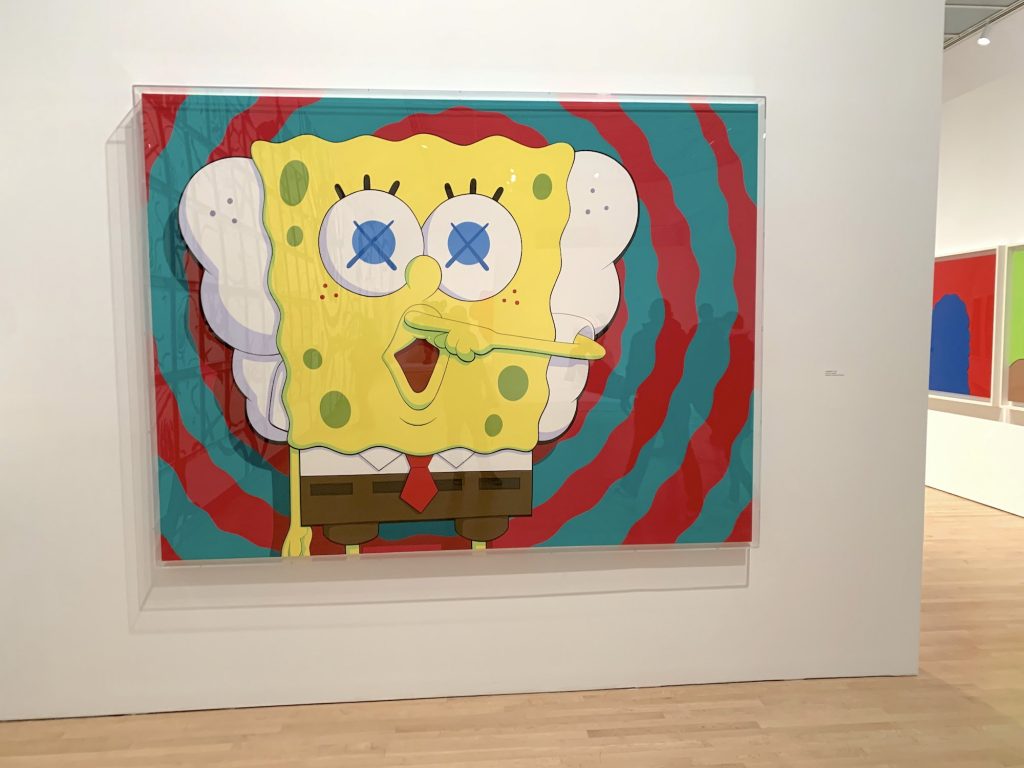
KAWS, Kawsbob 3 (2007). (Photo by Ben Davis)
Of course, another way people cope with stress and anxiety or bad thoughts is “retail therapy,” shopping to take your mind off whatever’s eating you, to feel in charge.
The fact that KAWS shows no interest in marking any difference between his painting and sculptures, on the one hand, and his collectible toys and branded collabs, on the other, doesn’t just open him up to a wider audience of fans. It has a meaning in terms of what kinds of psychic energies are invested in it. It means, quite literally, that it is accessible. It’s not trying to teach you anything. It’s only weird enough to make you feel as if you are in on something for liking it; not weird enough to make you feel alienated.
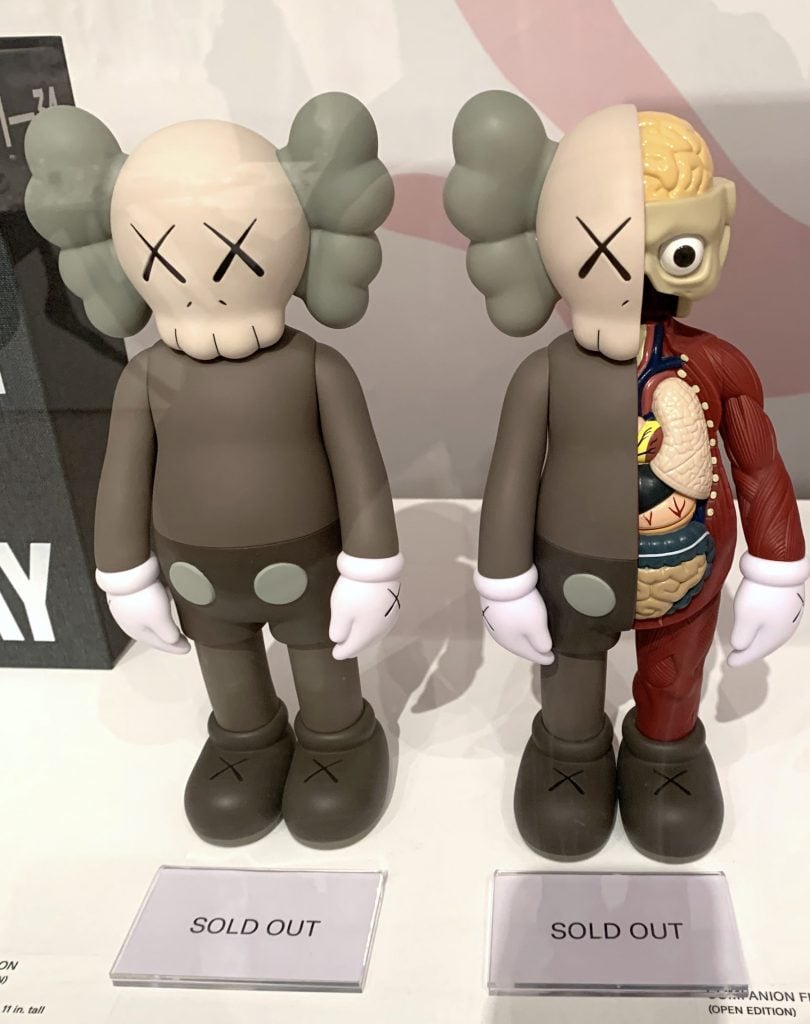
Figurines for sale in the gift shop for “KAWS: WHAT PARTY” at Brooklyn Museum, already sold out. (Photo by Ben Davis)
What I finally realized, standing there and staring at Tide, is how ambiguous its meaning is.
I don’t know, finally, what’s going on in this painting. Is the Companion drowning, at night, in the middle of the ocean, far away from land? Or is it chillin’ in the shallows, blissed out, in suspended animation in the moonlight?
Are we happily immersed in the accessible fun of KAWS’s self-contained product universe? Or are we drowning in its void, desperate for any scrap of meaning to hold onto? Maybe the two are sides of the same, flat image.
“KAWS: WHAT PARTY” is on view at the Brooklyn Museum of Art through September 5, 2021.